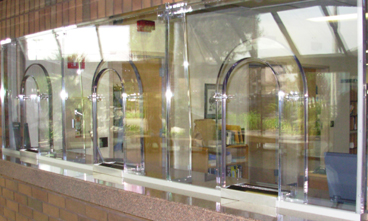Jim Richards | |
Security professionals or facility managers considering a bullet-resistant barrier for a clerk’s office, courthouse, or utility payment center need to be informed and ready to ask the right questions about bulletproofing for city and municipal offices.
Most municipal retrofits can be done overnight or during off-hours, and even complicated projects rarely take longer than a weekend. But guiding those projects through the design, approval, and permitting stages can drag on and on. A little preparation can prevent the kind of delays that botch budgets.Bulletproof Materials & Accessories for Municipal and Local Government Offices
Here are a few of the top considerations municipal offices when designing a ballistic barrier system, and important terms to know:
- Voice port: How will visitors and staff communicate through the barrier? We all dread the old-fashioned, crackling intercoms once common in subway stations and county lock-ups. Advanced fabrication techniques and ballistic materials have made it possible to rely on natural voice communication in most facilities, for crystal clear communication.
- Currency tray: This is the shallow steel tray used to pass papers through a bullet-resistant barrier.
- Package passer: For larger packages and envelopes, a barrier will need either custom package passers or prefabricated single-piece steel pass-through drawers.
- Glazing: This is the “bulletproof glass” itself—which is actually either a single piece of thick bullet resistant acrylic or a composite made of several laminated layers of bullet-resistant thermoplastic and tempered glass
- Frame: Holds the glazing in place. Comes in both rated bullet-resistant varieties, as well as non-rated equivalents for non-critical applications.
- Transaction window: Single-piece units that include glazing, framing, voice port, a passer or deal tray, and often a small countertop. They are shipped ready-to-install in an existing wall—no different than adding an interior window. Transaction windows are, by far, the most common solution for small government offices, payment centers, payroll offices, and so on.
Preparing To Work With A Bulletproof Contractor
According to Total Security Solutions Senior Sales Consultant Bob George, “We really just need some basic measurements and a few simple answers to get this conversation started.” Talk to your staff about the following four questions before calling, and you’ll be off to a solid start:
- “Fixed opening” or “large area”? A “fixed opening” refers to any opening smaller than a standard home window—for example, the check-in window at a doctor’s office or pharmacy is a “fixed opening.” A “large area” includes anything from the long counters at a county clerk’s office to an open lobby. Fixed openings can usually be secured with a prefabricated transaction window, while large areas call for a custom solution.
- Dimensions? The height and width of the opening that needs to be secured. When dealing with a large area, you’ll want to separately note the height of countertops, as these can often be reinforced with ballistic fiberglass.
- What level of protection do you need? Here’s a handy guide, but most municipal offices go with Level 3 or lower as a rule of thumb. Your bulletproof consultant will also want to know about the surrounding walls (drywall, for example, will need to be reinforced with ballistic fiberglass, while brick and concrete blocks are usually fine on their own).
- What do you need to accomplish on a daily basis? Describe your standard workday: How do staff best communicate with customers? Do they need to exchange papers? What about packages? Or accept deliveries? Do staff have a separate secure entrance, or will they need a reinforced bulletproof door connecting to an unsecured common area? Take some time to talk to front-line staff and observe them; workers often underestimate how often they have to accept packages or lean across a counter to help a client.



